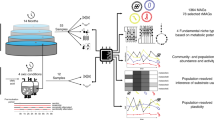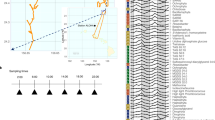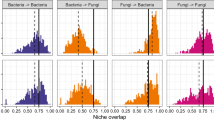Abstract
Different lifestyles, ranging from a saprophyte to a pathogen, have been reported in bacteria of one species. Here, we performed genome-wide survey of the ecological adaptation in four Burkholderia seminalis strains, distinguished by their origin as part of the saprophytic microbial community of soil or water but also including human and plant pathogens. The results indicated that each strain is separated from the others by increased fitness in medium simulating its original niche corresponding to the difference between strains in metabolic capacities. Furthermore, strain-specific metabolism and niche survival was generally linked with genomic variants and niche-dependent differential expression of the corresponding genes. In particular, the importance of iron, trehalose and d-arabitol utilization was highlighted by the involvement of DNA-methylation and horizontal gene transfer in niche-adapted regulation of the corresponding operons based on the integrated analysis of our multi-omics data. Overall, our results provided insights of niche-specific adaptation in bacteria.
Similar content being viewed by others
Log in or create a free account to read this content
Gain free access to this article, as well as selected content from this journal and more on nature.com
or
References
Agnoli K, Lowe CA, Farmer KL, Husnain SI, Thomas MS . (2006). The ornibactin biosynthesis and transport genes of Burkholderia cenocepacia are regulated by an extracytoplasmic function σ factor which is a part of the Fur regulon. J Bacteriol 188: 3631–3644.
Andersson U, Levander F, Rådström P . (2001). Trehalose-6-phosphate phosphorylase is part of a novel metabolic pathway for trehalose utilization in Lactococcus lactis. J Biol Chem 276: 42707–42713.
Berg G, Eberl L, Hartmann A . (2005). The rhizosphere as a reservoir for opportunistic human pathogenic bacteria. Environ Microbiol 7: 1673–1685.
d'Enfert C, Fontaine T . (1997). Molecular characterization of the Aspergillus nidulans treA gene encoding an acid trehalase required for growth on trehalose. Mol Microbiol 24: 203–216.
Drevinek P, Holden MTG, Ge Z, Jones AM, Ketchell I, Gill RT et al. (2008). Gene expression changes linked to antimicrobial resistance, oxidative stress, iron depletion and retained motility are observed when Burkholderia cenocepacia grows in cystic fibrosis sputum. BMC Infect Dis 8: 121.
Finelli A, Gallant CV, Jarvi K, Burrows LL . (2003). Use of in-biofilm expression technology to identify genes involved in Pseudomonas aeruginosa biofilm development. J Bacteriol 185: 2700–2710.
Foster AJ, Jenkinson JM, Talbot NJ . (2003). Trehalose synthesis and metabolism are required at different stages of plant infection by Magnaporthe grisea. EMBO J 22: 225–235.
Iwamoto K, Shiraiwa Y . (2005). Salt-regulated mannitol metabolism in algae. Mar Biotechnol 7: 407–415.
Lee Y-J, van Nostrand JD, Tu Q, Lu Z, Cheng L, Yuan T et al. (2013). The PathoChip, a functional gene array for assessing pathogenic properties of diverse microbial communities. ISME J 7: 1974–1984.
Lin ECC . (1961). An inducible D-arabitol dehydrogenase from Aerobacter aerogenes. J Biol Chem 236: 31–36.
Mahenthiralingam E, Baldwin A, Dowson CG . (2008). Burkholderia cepacia complex bacteria: opportunistic pathogens with important natural biology. J Appl Microbiol 104: 1539–1551.
Mathew A, Eberl L, Carlier AL . (2014). A novel siderophore‐independent strategy of iron uptake in the genus Burkholderia. Mol Microbiol 91: 805–820.
Morris CE, Kinkel LL, Xiao K, Prior P, Sands DC . (2007). Surprising niche for the plant pathogen Pseudomonas syringae. Infect Genet Evol 7: 84–92.
Patell S, Gu M, Davenport P, Givskov M, Waite RD, Welch M . (2010). Comparative microarray analysis reveals that the core biofilm‐associated transcriptome of Pseudomonas aeruginosa comprises relatively few genes. Environ Microbiol Rep 2: 440–448.
Rutala WA, Weber DJ . (1997). Water as a reservoir of nosocomial pathogens. Infect Control Hosp Epidemiol 18: 609–616.
Shiba K, Ito K, Yura T, Cerretti DP . (1984). A defined mutation in the protein export gene within the spc ribosomal protein operon of Escherichia coli: isolation and characterization of a new temperature-sensitive secY mutant. EMBO J 3: 631–635.
Sokol PA, Darling P, Lewenza S, Corbett CR, Kooi CD . (2000). Identification of a siderophore receptor required for ferric ornibactin uptake in Burkholderia cepacia. Infect Immun 68: 6554–6560.
Sriramulu DD, Nimtz M, Romling U . (2005). Proteome analysis reveals adaptation of Pseudomonas aeruginosa to the cystic fibrosis lung environment. Proteomics 5: 3712–3721.
Stopnisek N, Bodenhausen N, Frey B, Fierer N, Eberl L, Weisskopf L . (2014). Genus‐wide acid tolerance accounts for the biogeographical distribution of soil Burkholderia populations. Environ Microbiol 16: 1503–1512.
Vial L, Chapalain A, Groleau MC, Déziel E . (2011). The various lifestyles of the Burkholderia cepacia complex species: a tribute to adaptation. Environ Microbiol 13: 1–12.
Waite RD, Paccanaro A, Papakonstantinopoulou A, Hurst JM, Saqi M, Littler E et al. (2006). Clustering of Pseudomonas aeruginosa transcriptomes from planktonic cultures, developing and mature biofilms reveals distinct expression profiles. BMC Genomics 7: 162.
Acknowledgements
This work was supported by the Zhejiang Provincial Natural Science Foundation of China (R13C140001), the National Natural Science Foundation of China (31571971, 31371904 and 31200003), the Zhejiang Provincial Project (2014C32010), the Fundamental Research Funds for the Central Universities, the Agricultural Ministry of China (nyhyzx 201303015, 201003029 and 201003066) and the Key Subject Construction Program of Zhejiang for Modern Agricultural Biotechnology and Crop Disease Control (2010DS700124-KF1101, -KF1203, -KF1309 and -KF1410). We acknowledge the Hangzhou Woosen Biotechnology Co., Ltd, Zhejiang, China for the genome and transcriptome sequencing.
Author information
Authors and Affiliations
Corresponding authors
Ethics declarations
Competing interests
The authors declare no conflict of interest.
Additional information
Supplementary Information accompanies this paper on The ISME Journal website
Supplementary information
Rights and permissions
About this article
Cite this article
Zhu, B., Ibrahim, M., Cui, Z. et al. Multi-omics analysis of niche specificity provides new insights into ecological adaptation in bacteria. ISME J 10, 2072–2075 (2016). https://doi.org/10.1038/ismej.2015.251
Received:
Accepted:
Published:
Issue date:
DOI: https://doi.org/10.1038/ismej.2015.251
This article is cited by
-
Microbiome-based enrichment pattern mining has enabled a deeper understanding of the biome–species–function relationship
Communications Biology (2023)
-
Molecular characterization and in-depth genome analysis of Enterobacter sp. S-16
Functional & Integrative Genomics (2023)
-
Genome mining of secondary metabolites from a marine-derived Aspergillus terreus B12
Archives of Microbiology (2021)
-
Pan-genome diversification and recombination in Cronobacter sakazakii, an opportunistic pathogen in neonates, and insights to its xerotolerant lifestyle
BMC Microbiology (2019)



